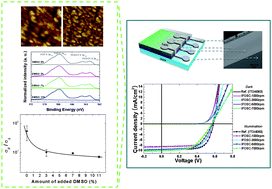A highly conductive poly(3,4-ethylenedioxythiophene):poly(styrene sulfonate) (PEDOT:PSS) film, obtained by addition of a polar solvent, dimethylsulfoxide (DMSO), to an aqueous solution of PEDOT:PSS, was thoroughly investigated to gain a deeper understanding of the fundamental characteristics of the solvent-modified PEDOT:PSS film. Use of the DMSO-modified PEDOT:PSS film as a transparent anode to achieve low-cost and high-efficiency ITO-free organic solar cells (OSCs) based on poly(3-hexylthiophene) (P3HT) and 1-(3-methoxycarbonyl)-propyl-1-phenyl-(6,6)C61 (PCBM) was also examined. Changes in the conductivity, morphology, surface composition, work-function, and anisotropic conductivity in both the parallel and perpendicular directions of solvent-treated PEDOT:PSS films that resulted from the addition of various amounts of DMSO were investigated to better understand the nature of the solvent-modified PEDOT:PSS film and the origin of its dramatically enhanced conductivity. Furthermore, the effects of using the modified PEDOT:PSS films as polymer anodes on solar cell performance were investigated by addition of various amounts of DMSO and by the use of PEDOT:PSS films with different thicknesses. The ITO-free OSCs with optimized PEDOT:PSS anodes had a high power conversion efficiency that was comparable to that of conventional ITO-based devices.

You have access to this article
 Please wait while we load your content...
Something went wrong. Try again?
Please wait while we load your content...
Something went wrong. Try again?


 Please wait while we load your content...
Please wait while we load your content...